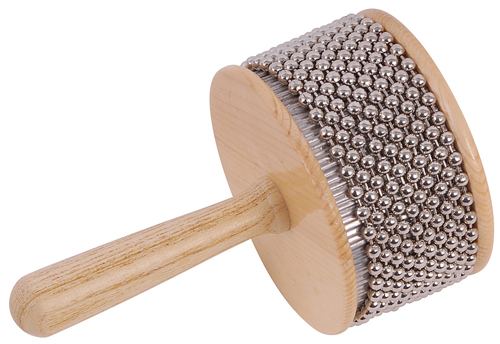Cabasa
Percussions
Africa
Between 1001 and 1900 AD
Video
The cabasa is a captivating percussion instrument known for its distinctive sound and versatility in various musical genres. With roots in African traditions and a modern evolution in Latin music, the cabasa has become a staple in ensembles ranging from jazz to flamenco.
It is classified as an idiophone, which means it produces sound primarily through the vibration of its material rather than through strings or membranes. Traditionally, the cabasa consists of a hollow cylindrical body—often made from wood or metal—wrapped with loops of steel ball chain. The instrument is held by a handle that allows for easy manipulation and playing. When played, the cabasa produces a unique rattling sound that can vary in tone depending on how it is struck or shaken. The rhythmic scraping sounds created by the beads sliding over the surface of the cylinder capture attention and add texture to musical compositions. Musicians can create a wide array of sounds by shaking, stroking, tapping, rubbing, or twisting the instrument. The cabasa’s design allows it to be played in various ways. For instance, players can use their non-dominant hand to apply pressure to the metal chain while holding the handle with their dominant hand. This technique enables them to produce precise rhythmic effects and dynamic sounds.
History and Origin
The history of the cabasa can be traced back to traditional African instruments like the shekere and agbe. These instruments were made from gourds with beads or shells attached to their surfaces. The cabasa’s modern form was developed in the 1960s by Martin Cohen, founder of Latin Percussion. Inspired by traditional designs, Cohen created a more durable and versatile version using metal materials. Cohen’s innovation involved wrapping steel ball chains around a cylindrical body, which enhanced the instrument’s sound quality and projection. His design revolutionized the way percussionists approached rhythm in Latin music genres such as salsa and bossa nova. As the cabasa gained popularity in Latin music circles, it also found its way into other genres like jazz, rock, and world music. Its distinctive sound has made it a favorite among musicians seeking to add unique textures to their compositions.
Working Mechanism
The cabasa produces sound through a combination of shaking and scraping motions. When a player shakes the instrument, the steel balls slide over the surface of the cylinder, creating a rattling sound that varies in intensity based on how forcefully it is played. The player can also create different timbres by applying pressure with their non-dominant hand while manipulating the handle. The construction material significantly influences the sound produced by the cabasa. For example, wooden cabasas tend to produce warmer tones compared to metal versions, which offer brighter and more cutting sounds. Additionally, variations in cylinder diameter and chain weight can affect pitch and resonance. Players often experiment with different techniques to achieve diverse sounds. For instance, they may rub or stroke the surface of the cylinder for softer sounds or tap it sharply for more pronounced effects. The versatility of playing styles makes the cabasa suitable for various musical contexts.
Types of Cabasas
Cabasas come in several types based on their construction materials and intended uses:
Wooden Cabasa: Made from solid wood with steel chains wrapped around it; these produce warm tones suitable for softer musical settings.
Metal Cabasa: Constructed from metal materials; these versions offer brighter sounds that cut through dense musical arrangements effectively.
Plastic Cabasa: Often used for educational purposes or by beginners; while they are more affordable, they may not produce as rich a sound as wooden or metal variants.
Specialty Cabasas: Some models include additional features such as flanges or sound ports that enhance tonal qualities or project sound differently.
Each type serves specific roles within musical ensembles while contributing uniquely to overall sound.
Uses of Cabasas
Cabasas are utilized across various musical genres:
Latin Music: The cabasa is commonly featured in salsa bands and bossa nova ensembles where its rhythmic capabilities enhance dance music.
Jazz: Many jazz musicians incorporate cabasas into their performances for added texture and complexity.
Flamenco: In flamenco music, cabasas provide essential rhythmic support alongside traditional guitar playing.
World Music: The versatility of the cabasa allows it to be integrated into diverse global music styles.
Music Therapy: Due to its engaging sounds and ease of play, cabasas are also used in therapeutic settings to promote interaction and creativity among participants.
Significance of Cabasas
The significance of the cabasa extends beyond its musical capabilities; it represents cultural heritage and community identity within Latin music traditions. As an instrument born out of innovation—stemming from traditional African designs—the cabasa embodies resilience through creativity. In educational contexts, learning how to play the cabasa fosters appreciation for diverse musical cultures while enhancing students’ rhythmic skills and coordination. Moreover, as global interest grows around world music traditions—cabasas serve as powerful tools for bridging cultural gaps through shared experiences among diverse audiences.
FAQ
What are the characteristics of a cabasa musical instrument?
The cabasa is a percussion instrument made of a cylindrical wooden or metal body wrapped in loops of steel ball chains. It produces a metallic, rhythmic sound when shaken or rotated against the hand. Known for its bright and crisp tone, the cabasa is used in Latin, jazz, and contemporary music for rhythm and texture.
What is the origin of the cabasa?
The cabasa has its origins in traditional African music, where it was made from a gourd covered with beads or shells. The modern version was popularized in Latin American music and redesigned with a durable cylindrical body and metal chains for ease of use and a sharper sound.
What are the types of cabasa available?
Cabasas come in various sizes and designs to suit different musical needs. Standard models are handheld, while larger, foot-operated cabasas are available for drum set players. Some cabasas are designed with adjustable bead tension to allow players to modify the instrument's sound and response.
 Links
Links
References
Other Instrument
Categories


















